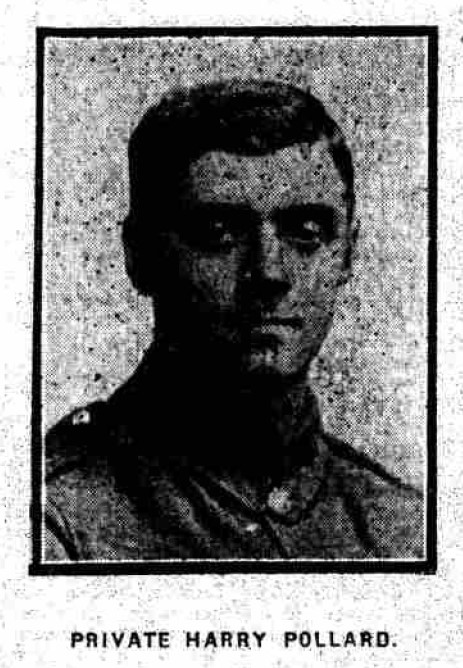Pte
Harry Pollard
Information about birth
|
Year of birth: 1883 |
|
Place of birth: Burnley, Lancashire, England, United Kingdom |
General information
|
Last known residence: 5 Richard Street, Burnley, Lancashire, England, United Kingdom |
|
Profession: Weaver |
Army information
|
Country: England, United Kingdom |
|
Force: British Expeditionary Force |
|
Rank: Private |
|
Service number: 36723 |
|
Enlistment date: 28/07/1916 |
|
Enlistment place: Preston, Lancashire, England, United Kingdom |
|
Units: — Leicestershire Regiment, 9th Bn. (Last known unit) |
Information about death
|
Date of death: 01/10/1917 |
|
Place of death: Joist Farm, Zonnebeke, Belgium |
|
Cause of death: Killed in action (K.I.A.) |
|
Age: 34 |
Memorial
|
Tyne Cot Memorial Panel: 51 |
Points of interest 4
| #1 | Place of birth | ||
| #2 | Last known residence | ||
| #3 | Enlistment place | ||
| #4 | Place of death (approximate) |
My story
Harry Pollard was born in Burnley, Lancashire, in 1883. His mother was Mary Pollard (born Redman). His father, John Thomas Pollard was a cotton weaver, Harry Pollard would follow in his father's footsteps. Harry Pollard had three brothers and a sister. He lived and worked in Burnley, where he married Emily Blythe in 1907. They had a son, Harold in 1909. Harry was called up for service in Preston, Lancashire, on 28 July 1916. He was assigned to the East Lancashire Regiment, 10th (Reserve) Battalion. In January 1917, Harry was transferred to the Leicestershire Regiment, 9th Battalion. In April, he was diagnosed with muscle pain and admitted to a field hospital. In June 1917, he rejoined his battalion.
On the night of 29-30 September 1917, the 9th Leicesters took over positions recently captured by Australian troops at Polygon Wood; these positions consisted of shell holes and German bunkers. The 9th Battalion was between Polygon Wood and Joist farm. On 1 October around 4.40 am, German artillery shelled Harry's Battalion's positions. After 40 minutes, the artillery fire stopped and the first wave of German troops attacked from Cameron Covert. A smoke screen in front of the lines was supposed to cover the German infantry's advance. However, the Germans suffered heavy losses from machine-gun and rifle fire and had to retreat. The second wave managed to penetrate the lines on the left flank, by which time SOS signals were sent out all along the front. To relieve the flanks, the 9th Battalion launched a counterattack on Joist Farm to buy time for reinforcements to arrive. This counterattack repulsed the second German attack. At 9.30 am, reinforcements arrived. German artillery continued shelling Polygon Wood throughout the day and deployed aircraft to escort the artillery. The battalion was relieved at 11pm on 5 October 1917 by the 9th battalion of the King's Own Yorkshire Light Infantry.
Harry Pollard, 34, was killed on 1 October 1917. No grave of Harry is known to date and he is commemorated on the Tyne Cot Memorial.
On the night of 29-30 September 1917, the 9th Leicesters took over positions recently captured by Australian troops at Polygon Wood; these positions consisted of shell holes and German bunkers. The 9th Battalion was between Polygon Wood and Joist farm. On 1 October around 4.40 am, German artillery shelled Harry's Battalion's positions. After 40 minutes, the artillery fire stopped and the first wave of German troops attacked from Cameron Covert. A smoke screen in front of the lines was supposed to cover the German infantry's advance. However, the Germans suffered heavy losses from machine-gun and rifle fire and had to retreat. The second wave managed to penetrate the lines on the left flank, by which time SOS signals were sent out all along the front. To relieve the flanks, the 9th Battalion launched a counterattack on Joist Farm to buy time for reinforcements to arrive. This counterattack repulsed the second German attack. At 9.30 am, reinforcements arrived. German artillery continued shelling Polygon Wood throughout the day and deployed aircraft to escort the artillery. The battalion was relieved at 11pm on 5 October 1917 by the 9th battalion of the King's Own Yorkshire Light Infantry.
Harry Pollard, 34, was killed on 1 October 1917. No grave of Harry is known to date and he is commemorated on the Tyne Cot Memorial.
Sources 5
|
"Missing after an action” (Burnley, Burnley Express, 24/11/1917). Sources used |
|
9 Battalion Leicestershire Regiment (The National Archives, Kew (TNA), WO 95/2165/2). https://www.nationalarchives.gov.uk/ Sources used |
|
Census Returns of England and Wales, 1911 (The National Archives, Kew (TNA), RG14). https://www.nationalarchives.gov.uk/ Sources used |
|
Richardson M., The Tigers : 6th, 7th, 8th, 9th (Service) battalions of the Leicestershire Regiment (Barnsley, Leo Cooper, 2000). Sources used |
|
War Office: Soldiers’ Documents, First World War (The National Archives, Kew (TNA), WO 363). https://www.nationalarchives.gov.uk/ Sources used |
More information 3
|
Commonwealth War Graves Commission Database https://www.cwgc.org/find-records/find-war-dead/casualty-details/1637100 |
|
Namenlijst (In Flanders Fields Museum) https://namenlijst.org/publicsearch/#/person/_id=39d42dc2-ff61-48f9-aa1e-af7a28c0a167 |
|
Lives of the First World War (Imperial War Museum) https://livesofthefirstworldwar.iwm.org.uk/lifestory/3544498 |
